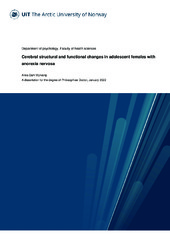| dc.contributor.advisor | Aslaksen, Per M | |
| dc.contributor.author | Myrvang, Anna Dahl | |
| dc.date.accessioned | 2022-05-05T11:41:51Z | |
| dc.date.available | 2022-05-05T11:41:51Z | |
| dc.date.issued | 2022-05-25 | |
| dc.description.abstract | Cerebral structural changes are associated with acute AN. Volume reduction is found in several regions, but it is unclear if this is a global phenomenon and how other morphological measures are affected. Cortical thickness (CTh) and surface area (CSA) are morphometrics that are less studied and develop with different trajectories in adolescence, when AN normally debuts. Alterations in the brains functional networks have been found in several studies, but findings are discrepant, and few have investigated multiple networks and in relation to core symptoms. A structure-function link is suggested but not established. This thesis aimed to investigate different morphometrics and multiple brain networks to improve our understanding of how AN affects connectivity in the developing brain and associations to symptoms, age and structural brain alterations.
Thirty young females with restrictive AN and healthy age-matched control participants were included in the study and underwent clinical screening and MR imaging. MR data was preprocessed and analyzed with state-of-the-art analysis methods.
Results showed that the hippocampus was reduced in AN, adjusted for whole brain volume and that most subfields were affected. Investigations of cortical thickness and surface area showed overlap between the two morphometrics, but some areas differed. Most of the brain appear to be affected by structural alterations. Among several functional networks studied, three showed reduced connectivity that was associated with age and cortical thickness.
Results indicate that the hippocampus and its subfields are reduced and perhaps more affected than the brain as a whole. Results strengthen previous findings regarding cortical thickness reduction. The study provides novel insight into cortical surface area reduction in adolescent AN and show with a novel method that may supersede traditional morphometrics, that most of the cortex is affected. Functional results indicate that development of connectivity is disrupted in AN and that a structure-function link may exist. | en_US |
| dc.description.doctoraltype | ph.d. | en_US |
| dc.description.popularabstract | Anorexia nervosa (AN) is a life-threatening eating disorder affecting young adolescents. Patients have serious changes in brain structure and function, but we have limited knowledge of the mechanisms behind this, particularly in adolescents where the brain is immature. By using MR-imaging, we investigated brain structure and activity in AN patients compared to healthy adolescents. We found that the hippocampus structure, essential for memory formation and emotional regulation, appeared to be particularly vulnerable in patients. We also found that the surface area and thickness of the cerebral cortex was related to body weight, suggesting that the brain changes are related to starvation. Brain networks were altered in patients and were related to age. Results from our study indicate that normal brain development is disturbed in young AN patients, perhaps as a consequence of starvation. | en_US |
| dc.description.sponsorship | Norges forskningsråd (NFR) | en_US |
| dc.identifier.uri | https://hdl.handle.net/10037/25021 | |
| dc.language.iso | eng | en_US |
| dc.publisher | UiT The Arctic University of Norway | en_US |
| dc.publisher | UiT Norges arktiske universitet | en_US |
| dc.relation.haspart | <p>Paper I: Myrvang A.D., Vangberg, T.R., Stedal, K., Rø, Ø., Endestad, T., Rosenvinge, J.H. & Aslaksen, P.M. (2018). Hippocampal subfields in adolescent anorexia nervosa. <i>Psychiatry Research Neuroimaging, 282</i>, 24–30. Also available at <a href=https://doi.org/10.1016/j.pscychresns.2018.10.007>https://doi.org/10.1016/j.pscychresns.2018.10.007</a>. Accepted manuscript version available in Munin at <a href=https://hdl.handle.net/10037/14595>https://hdl.handle.net/10037/14595</a>.
<p>Paper II: Myrvang A.D., Vangberg, T.R., Stedal, K., Rø, Ø., Endestad, T., Rosenvinge, J.H. & Aslaksen, P.M. (2021). Cerebral cortical thickness and surface area in adolescent anorexia nervosa: Separate and joint analyses with a permutation-based nonparametric method. <i>International Journal of Eating Disorders, 54</i>(4), 561–568. Also available in Munin at <a href=https://hdl.handle.net/10037/20220>https://hdl.handle.net/10037/20220</a>.
<p>Paper III: Myrvang A.D., Vangberg, T.R., Linnman, C., Stedal, K., Rø, Ø., Endestad, T., Rosenvinge, J.H. & Aslaksen, P.M. (2021). Altered functional connectivity in adolescent anorexia nervosa is related to age and cortical thickness. <i>BMC Psychiatry, 21</i>, 490. Also available in Munin at <a href=https://hdl.handle.net/10037/22918>https://hdl.handle.net/10037/22918</a>. | en_US |
| dc.rights.accessRights | openAccess | en_US |
| dc.rights.holder | Copyright 2022 The Author(s) | |
| dc.rights.uri | https://creativecommons.org/licenses/by-nc-sa/4.0 | en_US |
| dc.rights | Attribution-NonCommercial-ShareAlike 4.0 International (CC BY-NC-SA 4.0) | en_US |
| dc.subject | VDP::Samfunnsvitenskap: 200::Psykologi: 260 | en_US |
| dc.subject | VDP::Social science: 200::Psychology: 260 | en_US |
| dc.title | Cerebral structural and functional changes in adolescent females with anorexia nervosa | en_US |
| dc.type | Doctoral thesis | en_US |
| dc.type | Doktorgradsavhandling | en_US |


 English
English norsk
norsk
